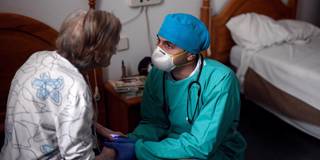Much emphasis has been placed on building lab capacity for polymerase chain reaction tests, the gold standard for detecting the COVID-19 virus. But such a strategy is unlikely to prove politically and financially sustainable. And too many people would still die.
CAMBRIDGE – In Massachusetts, which has a population of close to seven million, over 6,000 people have died from COVID-19 since the beginning of March. But one relatively small group – including about 38,000 people, or 0.5% of the state’s population – accounts for 60% of these deaths. This group comprises everyone who lives in nursing homes, and protecting these people and the staff who care for them, all of whom remain highly vulnerable to severe infection, must be a top priority everywhere as economies reopen.

CAMBRIDGE – In Massachusetts, which has a population of close to seven million, over 6,000 people have died from COVID-19 since the beginning of March. But one relatively small group – including about 38,000 people, or 0.5% of the state’s population – accounts for 60% of these deaths. This group comprises everyone who lives in nursing homes, and protecting these people and the staff who care for them, all of whom remain highly vulnerable to severe infection, must be a top priority everywhere as economies reopen.